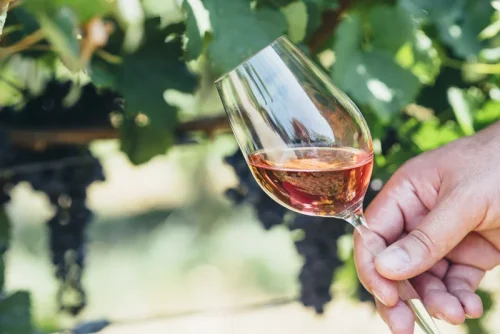
This resistance to nonabstinence treatment persists despite strong theoretical and empirical arguments in favor of harm reduction approaches. Additionally, given the nature of the COMBINE study, the effects of a medically oriented intervention (i.e., MM) without a pharmacological component could not be investigated. Furthermore, it should be noted that the literature does not offer consensus on the operational definition of drinking goal (Luquiens et al., 2011). Instead, the authors categorized responses to the Commitment to Abstinence item based largely on clinical judgment and prior research using this measure. To that end, it should be noted that the distribution of clinical outcomes across the controlled drinking vs abstinence three levels of drinking goal (complete abstinence, conditional abstinence, and controlled drinking) provided strong support for the validity of this coding system.

Moderation vs. Abstinence: Should You Cut Back or Quit Drinking Completely?

To date, however, there has been little empirical research directly testing this hypothesis. Advocates of nonabstinence approaches often point to indirect evidence, including research examining reasons people with SUD do and do not enter treatment. This literature – most of which has been conducted in the U.S. – suggests a strong link between abstinence goals and treatment entry. For example, in one study testing the predictive validity of a measure of treatment readiness among non-treatment-seeking people who use drugs, the authors found that the only item in their measure that significantly predicted future treatment entry was motivation to quit using (Neff & Zule, 2002).
2 Quality of life and recovery from AUD
Witkiewitz also arguedthat the commonly held belief that abstinence is the only solution may deter someindividuals from seeking help. It was also hypothesized that, given naltrexone’s effect on hedonic response to alcohol (King et al., 1997; McCaul et al., 2001; Ray et al., 2010), naltrexone would be more effective among those with a controlled drinking goal versus those with an abstinence oriented goal. This hypothesis was not supported by the data in that there was no significant drinking goal × naltrexone interaction in any of the outcome measures. This may be due to the fact that the vast majority of participants (78%) consumed alcohol during the trial, such that the drinking mediated effects of naltrexone were not restricted to patients with controlled drinking goals. The rationale and methods of the COMBINE study have been described in detail elsewhere (aCOMBINE Study Research Group, 2003a, COMBINE Study Research Group, 2003b).
‘Dangerous Data’ Part 7: Controlled Drinking Versus Abstinence: Who Decides? An Effectiveness Bank Hot Topic

We summarize historical factors relevant to non-abstinence treatment development to illuminate reasons these approaches are understudied. What remains controversial is the definition of alcohol dependency (alcoholism) and abuse. The AA’s stance, for example, is that anyone who can recover by drinking moderately was never an alcoholic in the first place. Brain imaging studies have revealed that heavy drinkers actually have damaged the part of the brain that can help control a drinking habit, which makes the pursuit of moderation not just a matter of strong will but rather a physical impossibility. Some people cannot get past step one, which is admitting that one is powerless over alcohol. Levy says that’s simply not true; heavy drinkers can stop drinking on their own, and his practice is proof of that.
- For example, among the 2005and 2010 National Alcohol Survey respondents, 18% of current drinkers who identified as“in recovery” from alcohol problems (who do not use drugs) are DSM-IValcohol dependent, and 26% of current drinkers who also use drugs are DSM-IV alcoholdependent.
- Furthermore, it should be noted that the literature does not offer consensus on the operational definition of drinking goal (Luquiens et al., 2011).
- This may be due to the fact that the vast majority of participants (78%) consumed alcohol during the trial, such that the drinking mediated effects of naltrexone were not restricted to patients with controlled drinking goals.
- We do not know whether the WIR sample represents the population of individualsin recovery.
- It is well known to clinicians and researchers in the field of alcoholism that patients vary with respect to drinking goal.
A new recovery is a process that begins with taking the first steps towards moderation management and clean life. You may struggle to find lasting joy if your moral values don’t align https://ecosoberhouse.com/ with your own. The study of relationships in society suggests that your moral values have a direct influence on your sense of self in society. Of the patients studied, 90% of total abstinence patients were still sober two and a half years after treatment. Only 50% of those who focused on controlled consumption succeeded in controlling their drinking.
- This is not to say one may not go thorough a period of “day at a time,” or “week at a time,” or even try a “harm reduction” approach.
- Abstinence is commonly used to refer to complete avoidance of sexual behaviors, particularly among children and adolescents.
- As noted by Adamson and colleagues (2010), treatment goals may change over the course of treatment and must be continuously evaluated in order to promote the best possible outcomes.
- In addition, while controlled drinking becomes less likely the more severe the degree of alcoholism, other factors—such as age, values, and beliefs about oneself, one’s drinking, and the possibility of controlled drinking—also play a role, sometimes the dominant role, in determining successful outcome type.
- Clinically, individuals considering non-abstinent goalsshould be aware that abstinence may be best for optimal QOL in the long run.Furthermore, time in recovery should be accounted for when examining correlates ofrecovery.
- This approach underestimates the compulsive nature of addiction and the neurological changes that occur with prolonged alcohol misuse.
![Hacked by Z-BL4CK-H4T [L4M]](https://annatravels.uk/wp-content/uploads/2023/11/anna-logo-1.png)